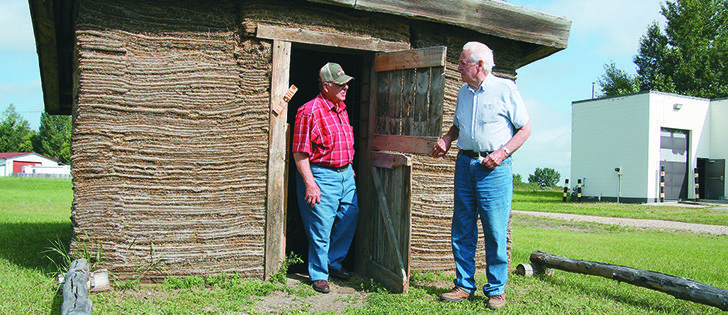Centennial project | Conditions harsh in ‘soddies’
BEISEKER, Alta. — Pungent earthy smells of a cave-like dwelling were part of pioneers’ first experiences living in sod houses on the Canadian Prairies.
“If it rained two days outside, it rained one day inside,” said Leah Uffelman, vice-president of the Beiseker Station Museum Society.
It built a sod house to mark Alberta’s centennial year of 2005, and show where many of their ancestors first lived when they came to stake their claims for a quarter section of land.
Armed with a $2,000 grant, Uffelman spearheaded a team of 23 volunteers who invested 300 hours of labour into building the structure that draws many visitors each year.
Read Also

Nutritious pork packed with vitamins, essential minerals
Recipes for pork
Their model, which was built near the village’s offices and museum, is seven sq. feet with a sloped grass roof and 30 centimetre thick walls.
It includes 1,400 sod rolls and is sparsely decorated with a table, bed and chair made of aspen logs.
Most soddies, as they were known, were built between the late 1800s and the First World War and replaced by wooden homes when rail lines were established and building materials could be shipped.
In the meantime, Uffelman said settlers made do with what they had.
“People were very ingenious to make things comfortable,” she said, citing their use of oilcloths, flour sacks, animal hides and canvass to cover the walls, windows and ceilings to keep it more watertight.
She said the settlers were far from forests but among plentiful grasslands.
Most were constructed close to creeks, where deep rooted sod was the hardiest building material for the soddies, cut with a specially designed plow into strips 81 centimetres long and 40 cm wide.
Thirteen to 15 cm thick sod was sliced and layered from slough bottoms to form the walls and aspen growing near creeks was used for support. The stoves used dried animal dung for cooking and heating.
“They had to use whatever there was,” said Uffelman.
Some prairie ones were built with two floors and others were whitewashed. Many had cellars dug under the house to store food, and all of them contended with insects, snakes and sprouting tree limbs.
They dotted the prairies in the early years in the district, when many Alberta pioneers moved up from the Dakotas. They also served as shelters for livestock, Uffelman said.
Sandra Rollings-Magnusson of Grant MacEwan College’s department of sociology, said many new immigrants were familiar with low dwellings dug into the earth and thatched roofs from their homes in Ukraine or Ireland.
“The pioneers really didn’t have finances so were forced to use what was on the land,” she said.
Some were temporary dwellings as small as 2.4 by 2.4 metres or 2.4 by 3.6 with people sleeping in tables, small beds or wherever they could lay a matt.
“It was actually quite miserable, especially dealings with critters and the bugs,” Rollings-Magnusson said.
Additions were made as children were added and refurbishments were essential, she said. A roof would disintegrate within three years if nothing was done, she said.
“It would have been rough in the winter. I don’t know how they managed,” she said. Livestock often died because of a lack of shelter in harsh prairie weather and no protection from the elements, Rollings-Magnusson said.
Some made it more cosy by pasting newspaper or magazines to the walls.
Others dug out the mud floor and burnt, swept and packed it to make it more solid. Sheets and blankets would be hung to create room dividers for privacy, she said.
They were temporary shelters, but some lived in them for as long as seven years, said Rollings-Magnusson.
Some returned to soddies because of their better insulation values during weather extremes.
But as people became more established, most moved into more permanent wooden dwellings.
“There’d be a stigma there as they’d look down on those people still living in soddies,” Rollings-Magnusson said.
The Addison sod house near Kindersley, Sask., a national historic site, is the last soddie standing today in the West.

















